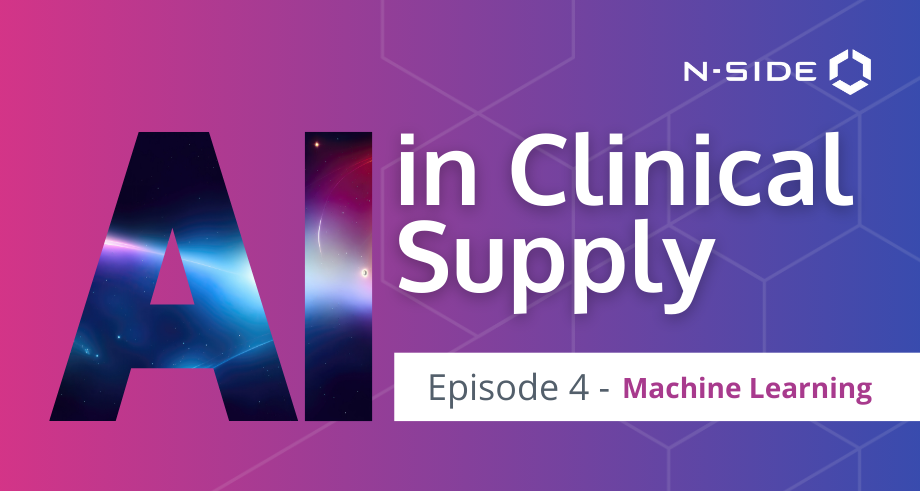AI in Clinical Supply Chain - Episode 4


 Amaury Jeandrain
Amaury Jeandrain
Which AI Method for Clinical Supply?
[EPISODE 4] - Machine Learning
We often hear that history repeats itself. Can you imagine being able to predict the future based on events of the past? This is what Machine Learning, or ML, is attempting to do. It is generally recognized as being the most widely used and impactful AI technology of the past decades.
ML is a broad category that includes any algorithm or model that learns from data to make predictions, classifications, or decisions. The goal is often to find patterns, define processes, and forecast the future based on past data. Generative AI itself is a subset of Machine Learning.
It is therefore understandable that the distinction between the two can be confusing, especially since there is some overlap in the capabilities of Machine Learning (ML) and Generative AI (GenAI).
While both technologies can perform similar tasks, the key difference is in their focus.
Machine Learning
ML is more broadly known for understanding patterns and supporting prediction, decisions, and forecasting based on past data, for specialized and given problems (generally numbers).
Generative AI
GenAI not only analyzes or predicts, but is able to do so for a larger range of problems (text, images, code, language, etc.) based on the content it has been trained on. Rather than creating truly "new" content, GenAI predicts outcomes within a much broader and more complex space, leveraging large-scale patterns learned from diverse training data.
Applications of ML in clinical supply
Clearly, our first thoughts go towards forecasting demands & recruitments based on past data. These could be applied to wide data sets of past clinical trials, although data access is complicated due to being proprietary to each pharmaceutical company. Also, therapeutic indications and protocols tend to be so specific that past data might not be accurately predicting outcomes for any trial. But it can be provided as a starting point.
Then, Machine Learning could also be used to learn on a trial’s past data, especially if the sample size (number of patients) and trial duration are high. This would support constantly updating recruitment, titration, and demand projections based on real observations.
ML could also support risk assessment and safety stock optimization. By assessing the variability of past supply chain data (lead times, quality issues, etc.), it could help forecast disruptions. Linked to the forecasted demand, it could help determine ideal inventory levels at sites and depots that avoid shortages.
Combined Applications of ML and GenAI
As we already spoke at length of the applications of GenAI, we will focus here on the impact of combining it with other ML techniques such as data entry and formatting, forecast analysis, or content creation based on latest forecasts.
In the cases of using ML to generate demand forecasts and inventory recommendations, GenAI can support data cleaning to feed the algorithm, while also helping the supply chain manager analyze the forecasts and identify potential risks.
This brings us to cases of automation. GenAI could generate reports based on the forecasts to share recommendations with the relevant stakeholders (CMOs, distributors, etc.), and even dynamically update orders, production plans, and other supply chain actions.
But, as both are based on past data, they have blind spots when it comes to external factors that are not a part of the training data. If we used history to predict the future of humanity, we would not be able to predict the long-term effects of technological evolution. In clinical trials, protocol-specific demand and recruitment variations, geopolitical uncertainties, and delays, are so many factors that can not be predicted by past data.
This is where other technologies can fill in. In our previous articles, we talked about simulations & optimization as well. If these are brought into the mix, we could end up with the following scenario in clinical supply planning:
- ML provides recruitment forecasts & patient specificities (titrations, drop-out, weights, etc.) based on past data
- GenAI eases data entry into the forecasting system
- Simulations predict future demand and its uncertainty based on the ML-generated forecasts and protocol specificities, and simulate the supply chain’s flows and risks.
- Optimization creates a supply chain strategy that covers the simulated demand and covers identified risks, while optimizing inventories.
- Simulation can be used once again for scenario testing, sensitivity analysis, and risk mitigation in case of disruptions
- GenAI can interpret results and share outcomes in the right format with the right stakeholders. It can also analyze real-time data to identify potential risks.
- ML uses the trial’s own past data to re-forecast future recruitment & demands
- And the cycle starts again
On top of supporting data entry and results interpretation, we could see AI acting as a pilot for the ML, simulation, and optimization models, therefore making itself into an interface between the user and the algorithm. This is called agentic AI, and we will surely hear more about it in the future.
Conclusion: Navigating the AI landscape for clinical supply chain optimization
As we wrap up this series on AI, we've explored the key AI technologies transforming the clinical supply. From the rapid rise of Generative AI (GenAI), capable of automating data analysis, content creation, and enhancing user interfaces, to the deep predictive power of Simulations and Mathematical Optimization, each method brings unique strengths to the table.
In Episode 1, we discussed how Generative AI plays a crucial role in streamlining data processing, improving visualization, and automation solutions for clinical supply teams. However, we also highlighted its limitations in complex prediction tasks, underscoring the need for other AI methods to complement it.
In Episode 2, Simulations proved indispensable for predicting potential future scenarios, scenario-test trial designs, and conducting risk assessments, while working hand-in-hand with other AI tools to deliver data-backed insights.
Mathematical Optimization, covered in Episode 3, demonstrated its power in making precise optimal decisions based on complex constraints, ensuring supply chain decisions are not only well-informed but optimal in terms of cost and efficiency.
Finally, this last episode introduced Machine Learning (ML) as a cornerstone technology for predictive analytics in clinical trials. ML excels at uncovering patterns in past data, enabling future demand forecasting based on past observations, and identifying deviation likelihoods. When combined with GenAI, Simulations, and Optimization, ML can drive a more robust, data-driven supply chain strategy.
Together, these AI technologies, while distinct, work synergistically to solve the complex challenges of clinical supply chains. By integrating these tools, pharmaceutical companies can enhance forecasting accuracy, optimize resource allocation, mitigate risks, and drive overall efficiency in clinical trials.
The future of clinical supply chain management lies in the strategic combination of these AI techniques, paving the way for smarter, more resilient operations. As we look ahead, the evolving landscape of AI in the Life Sciences industry will continue to present exciting opportunities for innovation, ensuring clinical trials are more efficient, faster, and cost-effective.
AI at N-SIDE
As an optimization company, N-SIDE has been successfully using AI for more than 20 years in over 12.000 clinical trials. Optimization, simulations, and machine learning algorithms are native to our solutions.
Wish to learn more about how N-SIDE uses AI to reduce drug waste and risks in the clinical supply chain, while saving time and money? Book a meeting with one of our experts.



About the Author
Amaury is N-SIDE's Strategy Advisor for clinical supply chain solutions. Within his 9 years in the industry, Amaury’s objective has been to revolutionise planning and systems to make clinical supply chain more efficient, more ethical, less wasteful and more patient-centric.
Amaury Jeandrain






